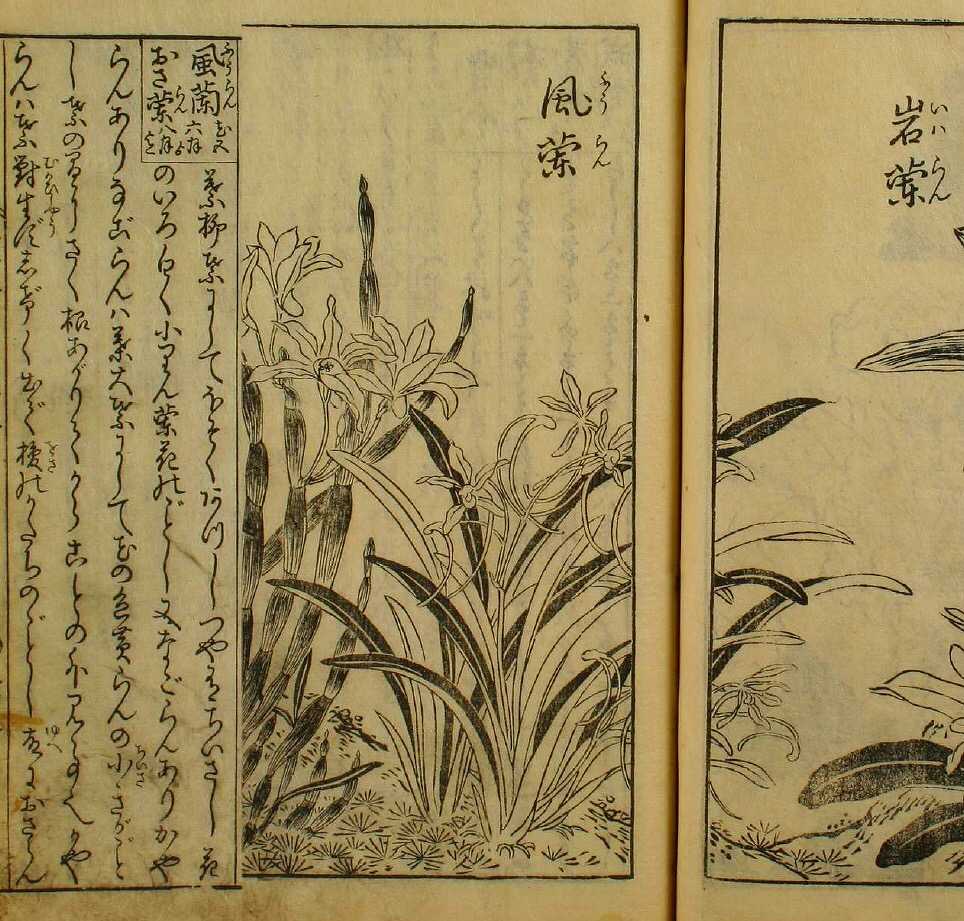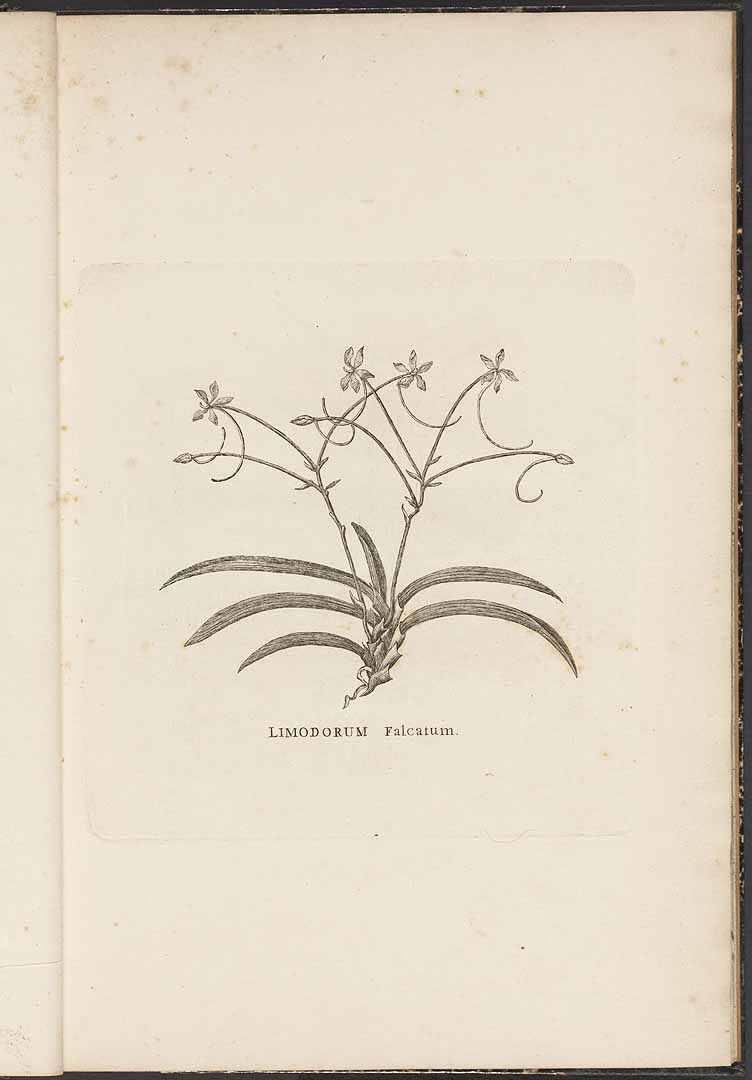Sirius
Plant Nerd
- Joined
- Jan 28, 2008
- Messages
- 476
- Reaction score
- 0
A Historical Timeline
1712 - Wakan Sansai Zue is published by Terashima Ryoan.
三才図会に云ふ、風蘭は土あらずして生く。小さき籃(かご)に貯へて樹の上に掛く。人、仙草と称す。細なる 花微かに香し。五雑組に云ふ、風蘭は根土に着かずして木石の上に叢り蟠(またが)り、取りて之れを(のき) の際に懸く。時に風の為に吹かるときは愈々茂盛す。其の葉花家蘭と全く異なること無し。按ずるに、風蘭は深 山に之れ有り(かや)み)等の幹(えだ)の間に多く之れ有り。葉の形万年青に似て細く小さく、其の長さ二、 三寸、六月に一茎を抽(ぬ)き小白花を開く。末(すえ)曲り微かに香し。
"According to Sancai Tuhui (a Chinese encyclopedia), Fûran grows w/o soil. It is placed in a small basket and then on a tree. People call this Sen Sô (Celestial Herb/Weed). Small flowers have a light fragrance. According to 五雑組 (another Chinese encyclopedia), roots of Fûran never touch soil and mount on trees and rock. People hang this from eaves after collection (from wild). It grows well when breezy. There is no difference between leaves and flowers of this and those of ordinary orchids.
I contemplate that the habitat of Fûran is deep in mountains, and many are found on branches of Torreya nucifera, Abies firma, and such. Leaves look like Rohdea japonica, but small and narrow. The length of leaves are 2~3 inches. An inflorescence will emerge in June, and bear small white flowers. The tip of flower is bent, and has a weak fragrance."
Source: Translation credit given to Orchidboard user Kentaki. View the thread: Click Here
1755 - Ehon No Yamagusa by author Tachibana Yasukuni depicts Fuuran along with other orchids on plate 27.

Source: Orchidboard See the whole book: Click Here
1784 - Carl Peter Thunberg introduces the type species Orchis falcata to the Western World from Japan.

Source: Thunberg's Original Collected Specimen
1794 - Thunberg publishes Icones plantarum japonicarum Plate 6 features Limodorum falcatum.

Source: Biodiversity Heritage Library See the whole book: Click Here
1893 - In the book A Manual of Orchidaceous Plants Cultivated Under Glass in Great Britain Vol. 2 published by Veitch & Sons, the plant is described as Angraecum falcatum.
A. falcatum.
A diminutive plant. Stems 1—2 inches high, each with 3—5 somewhat falcately linear, acute leaves, 2—3 inches long, channelled on the face, sharply keeled beneath. Peduncles shorter than the leaves, 3—5 or more flowered. Flowers fragrant, milk-white, about £ inch in diameter, on slender pedicels 2 inches long; sepals and petals similar and equal, linear-oblong, acute; lip three-lobed, the side lobes minute, tooth-like, the intermediate lobe narrowly oblong, retuse; spur filiform, curved, as long as the pedicel.
Angrtecum falcatum, Lindl. Gen. ct Sp. Orch. p. 237, in note (1832), sub. CEceoclades falcata. Benth. in Journ. Linn. Soc. XVIII. p. 336 (1881). Limodorum falcatum, Swartz in Nov. Act. Up. VI. p. 79 (1799). BoL Beg. t. 283 (1818). Bot. Mag. t. 2097. CEceoclades falcata, Lindl. Gen. & Sp. Orch. p. 237 (1882). Franeh. et Sav. Enum. pi. Jap. II. p. 28. Aerides Thunbergii, Miq. Prod. p. 137. S6 Mokou, XVIII. fol. 24. Orchis falcata, Thunb. Fl. jap. p. 26.
The unpretending little orchid described above has an exceptional interest attached to it, not only from a scientific point of view on account of its geographical position and from the difficulty experienced by the older botanists in determining its systematic place, but also in a horticultural sense as being the first Angraecum cultivated in the glass-houses of Europe, and one of the earliest of the Japanese orchids ever introduced.
It was detected on the hills near the port of Nagasaki in southern Japan by Thunberg some time between 1773 and 1778.* So little was known at that time of the epiphytal orchids that Thunberg at first referred it to the terrestrial genus Orchis, with which it has but a slender affinity, but subsequently removed it to Limodorum, a monotypic genus widely dispersed over the Mediterranean region, to which it is scarcely more nearly related than to Orchis. In this, however, he was followed by his countryman Swarz, the greatest orchid authority of his time, and doubtless owing to the influence of this authority it was figured both in the Botanical Register (1818) and in the Botanical Magazine (1819) under the name of Limodorum falcatum. Lindley, was the first botanist to bring it under Angrscum, but afterwards removed it to Qiceoclades, a genus which he had founded upon a Brazilian plant previously described and figured as an Aiigraecum,t but now somewhat doubtfully referred to Eulophia; the other species brought by Lindley under (Eceoclades were removed by Eeichenbach to Saccolabium with the exception of the little Japanese plant, our present subject, which he seems to have overlooked. This enlargement of Saccolabium was sanctioned by Bentham, who, however, rightly restores the Japanese plant to the genus in which Lindley first placed it.) That a species of Angraecum should be found in a country so remote from its congeners as Japan, is a phenomenon for which no explanation can be offered.
Angraecum falcatum was first introduced into British gardens by Dr. Roxburgh, who sent plants to Sir Abraham Hume about the year 1813, and by whom they were cultivated in a hot-house in his garden at Wormley Bury, near Cheshunt. It probably became lost to cultivation for a number of years, till it was re-introduced by ourselves and other firms from its native country within the last quarter of a century. Besides the locality in which it was first detected by Thunberg, it has been reported from Kiu-siu and Kin-bo-san.
* Carl Peter Thunberg was a Swedish physician and botanist, a pupil and one of the immediate successors of Linnaeus in the Chair of Botany in the University of Upsal. In 1771 he obtained a situation as surgeon to one of the Dutch East India Company's vessels, and sailed from Amsterdam for the East. He landed at the Cape of Good Hope and made several excursions into the interior, and after having remained at the Cape three winters he sailed in 1773 for Java, and subsequently visited Japan. He returned to his native country in 1779, and published a Flora Japonica in 1784.
t Bot. Reg. t. 618. + Gen. Plant. III. p. 579,
Source: Google Books - Read the whole book: Click Here
1712 - Wakan Sansai Zue is published by Terashima Ryoan.
三才図会に云ふ、風蘭は土あらずして生く。小さき籃(かご)に貯へて樹の上に掛く。人、仙草と称す。細なる 花微かに香し。五雑組に云ふ、風蘭は根土に着かずして木石の上に叢り蟠(またが)り、取りて之れを(のき) の際に懸く。時に風の為に吹かるときは愈々茂盛す。其の葉花家蘭と全く異なること無し。按ずるに、風蘭は深 山に之れ有り(かや)み)等の幹(えだ)の間に多く之れ有り。葉の形万年青に似て細く小さく、其の長さ二、 三寸、六月に一茎を抽(ぬ)き小白花を開く。末(すえ)曲り微かに香し。
"According to Sancai Tuhui (a Chinese encyclopedia), Fûran grows w/o soil. It is placed in a small basket and then on a tree. People call this Sen Sô (Celestial Herb/Weed). Small flowers have a light fragrance. According to 五雑組 (another Chinese encyclopedia), roots of Fûran never touch soil and mount on trees and rock. People hang this from eaves after collection (from wild). It grows well when breezy. There is no difference between leaves and flowers of this and those of ordinary orchids.
I contemplate that the habitat of Fûran is deep in mountains, and many are found on branches of Torreya nucifera, Abies firma, and such. Leaves look like Rohdea japonica, but small and narrow. The length of leaves are 2~3 inches. An inflorescence will emerge in June, and bear small white flowers. The tip of flower is bent, and has a weak fragrance."
Source: Translation credit given to Orchidboard user Kentaki. View the thread: Click Here
1755 - Ehon No Yamagusa by author Tachibana Yasukuni depicts Fuuran along with other orchids on plate 27.

Source: Orchidboard See the whole book: Click Here
1784 - Carl Peter Thunberg introduces the type species Orchis falcata to the Western World from Japan.

Source: Thunberg's Original Collected Specimen
1794 - Thunberg publishes Icones plantarum japonicarum Plate 6 features Limodorum falcatum.

Source: Biodiversity Heritage Library See the whole book: Click Here
1893 - In the book A Manual of Orchidaceous Plants Cultivated Under Glass in Great Britain Vol. 2 published by Veitch & Sons, the plant is described as Angraecum falcatum.
A. falcatum.
A diminutive plant. Stems 1—2 inches high, each with 3—5 somewhat falcately linear, acute leaves, 2—3 inches long, channelled on the face, sharply keeled beneath. Peduncles shorter than the leaves, 3—5 or more flowered. Flowers fragrant, milk-white, about £ inch in diameter, on slender pedicels 2 inches long; sepals and petals similar and equal, linear-oblong, acute; lip three-lobed, the side lobes minute, tooth-like, the intermediate lobe narrowly oblong, retuse; spur filiform, curved, as long as the pedicel.
Angrtecum falcatum, Lindl. Gen. ct Sp. Orch. p. 237, in note (1832), sub. CEceoclades falcata. Benth. in Journ. Linn. Soc. XVIII. p. 336 (1881). Limodorum falcatum, Swartz in Nov. Act. Up. VI. p. 79 (1799). BoL Beg. t. 283 (1818). Bot. Mag. t. 2097. CEceoclades falcata, Lindl. Gen. & Sp. Orch. p. 237 (1882). Franeh. et Sav. Enum. pi. Jap. II. p. 28. Aerides Thunbergii, Miq. Prod. p. 137. S6 Mokou, XVIII. fol. 24. Orchis falcata, Thunb. Fl. jap. p. 26.
The unpretending little orchid described above has an exceptional interest attached to it, not only from a scientific point of view on account of its geographical position and from the difficulty experienced by the older botanists in determining its systematic place, but also in a horticultural sense as being the first Angraecum cultivated in the glass-houses of Europe, and one of the earliest of the Japanese orchids ever introduced.
It was detected on the hills near the port of Nagasaki in southern Japan by Thunberg some time between 1773 and 1778.* So little was known at that time of the epiphytal orchids that Thunberg at first referred it to the terrestrial genus Orchis, with which it has but a slender affinity, but subsequently removed it to Limodorum, a monotypic genus widely dispersed over the Mediterranean region, to which it is scarcely more nearly related than to Orchis. In this, however, he was followed by his countryman Swarz, the greatest orchid authority of his time, and doubtless owing to the influence of this authority it was figured both in the Botanical Register (1818) and in the Botanical Magazine (1819) under the name of Limodorum falcatum. Lindley, was the first botanist to bring it under Angrscum, but afterwards removed it to Qiceoclades, a genus which he had founded upon a Brazilian plant previously described and figured as an Aiigraecum,t but now somewhat doubtfully referred to Eulophia; the other species brought by Lindley under (Eceoclades were removed by Eeichenbach to Saccolabium with the exception of the little Japanese plant, our present subject, which he seems to have overlooked. This enlargement of Saccolabium was sanctioned by Bentham, who, however, rightly restores the Japanese plant to the genus in which Lindley first placed it.) That a species of Angraecum should be found in a country so remote from its congeners as Japan, is a phenomenon for which no explanation can be offered.
Angraecum falcatum was first introduced into British gardens by Dr. Roxburgh, who sent plants to Sir Abraham Hume about the year 1813, and by whom they were cultivated in a hot-house in his garden at Wormley Bury, near Cheshunt. It probably became lost to cultivation for a number of years, till it was re-introduced by ourselves and other firms from its native country within the last quarter of a century. Besides the locality in which it was first detected by Thunberg, it has been reported from Kiu-siu and Kin-bo-san.
* Carl Peter Thunberg was a Swedish physician and botanist, a pupil and one of the immediate successors of Linnaeus in the Chair of Botany in the University of Upsal. In 1771 he obtained a situation as surgeon to one of the Dutch East India Company's vessels, and sailed from Amsterdam for the East. He landed at the Cape of Good Hope and made several excursions into the interior, and after having remained at the Cape three winters he sailed in 1773 for Java, and subsequently visited Japan. He returned to his native country in 1779, and published a Flora Japonica in 1784.
t Bot. Reg. t. 618. + Gen. Plant. III. p. 579,
Source: Google Books - Read the whole book: Click Here
Last edited:












































